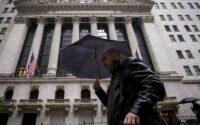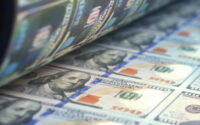Stock market outlook: Why Nobel winner Robert Shiller’s CAPE metric sees S&P 500 heading below 3,000
Stocks have suffered a rough September, with the S&P 500 dropping from 4,516 at the month’s start to 4,275 by midday on September 26, a drop of 5.3% in just 18 trading days.
Of course, the apparent cause is the sharp, sudden spike in long-term interest rates, epitomized by the month-to-date leap in the 10-year Treasury yield by almost 50 basis points to 4.55%. So far, neither the rise in rates nor the cratering in stocks has done much to stir the Wall Street bulls to lower their forecasts for 2023, with Goldman Sachs predicting a year-end number of 4,500, and Citigroup at 4,600.
In fact, if you believe the analysts’ earnings predictions for the next few quarters, an outcome where the index re-traces its August highs, then keeps chugging forward next year, appears plausible. On average, the market strategists forecast that trailing 12-month GAAP profits rise from $200 per share in the first quarter to $230 per share in the second quarter of next year. If that happens, America’s big caps could reach over 4,800 at what the bulls would consider a modest price-to-earnings ratio, or PE, of 21x by next summer. So why worry?
The bull case numbers don’t add up
The rub: The current market math suggests that a PE even in the low 20x range is too high, and earnings are more likely to drop substantially from here than wax by 15% in just four quarters to $230.
Let’s start with profits. Corporate earnings are highly cyclical and erratic. They regularly spike to unattainable heights or drop to levels from which they’re bound to rebound. Right now, S&P earnings per share are experiencing the former phenomenon. Nobel Prize laureate and Yale professor Robert Shiller offers a metric called the Cyclically adjusted price-earnings ratio, or CAPE, that removes those steep peaks and deep valleys, and smoothes the numbers to get a figure for bedrock, repeatable profits. It calculates a 10-year average of inflation-adjusted EPS, then uses those recast earnings to judge if stocks are over or undervalued.
Right now, the CAPE EPS stands at $145. AQR, one of America’s great quant firms, is said to mark the CAPE up by around 10% to get what they consider the best real-time estimate. That’s because the CAPE only increases past profits for inflation, not for “real” gains usually tied to economic growth. The 10% mark-up provides that lift. Add the premium, and the best measure of where earnings should settle is around $160 (Shiller’s $149 plus 10%).
Hence, the Shiller formula implies that by reverting to the mean, EPS will trend not upwards from here, but southwards toward $160. Now, we need a normalized PE multiple to attain a reasonable valuation for the S&P. Here’s where the stunning rise in the 10-year is so decisive. What matters in calculating how many dollars investors will pay for each sawbuck in earnings isn’t the “nominal” but the “real” yield. Companies raise prices to cover their costs, so their revenues should increase in tandem with relatively modest inflation. What’s punishing is a wide premium over and above the CPI that investors can get from purchasing bonds instead of stocks. When real rates are elevated, fixed income gets a lot more attractive, and equities lose their luster.
That’s precisely the threat today. The real 10-year rate equals the yield on 10-year TIPS, or treasury inflation protected securities. The recent jump in the long bond has driven the TIPS rate to 2.37%, the highest number in 20 years, excluding a brief explosion in the GFC. TIPS offers folks and funds a return of 2.37% points over projected inflation, on totally safe bonds. That’s a lot of competition from stocks, which are anything but safe, and seldom riskier than right now.
Of course, investors demand a premium over the risk-free real rate to choose equities, given their careening course, over the safety of Treasuries. Typically, that spread––known as the equity risk premium, or ERP––averages around 3.5 points. So the best estimate of the return investors expect from stocks going forward is 5.9%, which is the 3.5% ERP plus the real yield of 2.37%, plus inflation.
To get a 5.9% real return, a basket of stocks must pay you $5.90 for every $100 you invest. That’s a PE of roughly 17, which by the way, is around the S&P average over the past 150 years, though it’s been much higher in past decade of Fed-engineered, super-low rates.
A multiple of 17 times our “normalized” earnings estimate of $160 gives an S&P of 2,720. That’s 43% lower than the level on September 26.
To be sure, a 40% drop may not be in our future. But a big decline is certainly feasible, because that’s what the hard math implies. It’s reasonable to believe that the real rate could fall to 1% from 2.37% if economic growth remains at the subdued, post-Great Financial Crisis levels. But even if that happens, the PE would hover at 22, and a reasonable S&P reading would be 3,500, 18% below the mark on September 26.
Put simply, the super-low and even negative real rates in recent years led to super-high PE multiples that the bulls wrongly assumed would endure. At the same time, profit margins hit virtually never-before-seen heights that also couldn’t last. The liftoff in real rates is what could easily pop the balloon. You may want to put a lot more faith in the math than in the bull scenario that’s likely to prove bull.
[ad_2]
Source link


